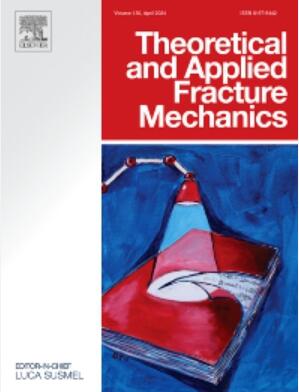Improved probabilistic design method to quantify the fracture properties of roller compacted concrete
IF 5
2区 工程技术
Q1 ENGINEERING, MECHANICAL
引用次数: 0
Abstract
In this paper, the material parameters pertaining to fracture properties of Roller Compacted Concrete (RCC) were evaluated using the boundary element method (BEM). The fictitious crack growth length is determined by the relative size , while the individualized values of material parameters of RCC for different water-to-cement ratios were obtained. In this study, the three-parameter Weibull fracture statistical model was proposed for the first time to analyze the discreteness of these individualized values of material parameters of RCC. The statistical analysis minimum value of material parameters of each group is obtained. The failure curves of each group of RCC were predicted from the three-parameter Weibull fracture statistical model, and the simple calculation model for material parameters was validated. Further, a two-point design method was proposed for RCC material parameters with varying strengths and water-to-cement ratios.
量化碾压混凝土断裂性能的改进型概率设计方法
本文采用边界元法(BEM)评估了与辊压混凝土(RCC)断裂性能有关的材料参数。虚构裂缝生长长度 Δafic 由相对尺寸 (T-a0)/di 确定,同时得到了不同水灰比下 RCC 材料参数 (KIC&ft) 的个性化值。本研究首次提出了三参数 Weibull 断裂统计模型来分析这些 RCC 材料参数(KIC&ft)个性化值的离散性。统计分析得到了每组材料参数(KIC&ft)的最小值。根据三参数 Weibull 断裂统计模型预测了各组 RCC 的破坏曲线,并验证了材料参数 (KIC&ft) 的简单计算模型。此外,还针对不同强度和水灰比的 RCC 材料参数(KIC&ft)提出了两点设计方法。
本文章由计算机程序翻译,如有差异,请以英文原文为准。
求助全文
约1分钟内获得全文
求助全文
来源期刊

Theoretical and Applied Fracture Mechanics
工程技术-工程:机械
CiteScore
8.40
自引率
18.90%
发文量
435
审稿时长
37 days
期刊介绍:
Theoretical and Applied Fracture Mechanics'' aims & scopes have been re-designed to cover both the theoretical, applied, and numerical aspects associated with those cracking related phenomena taking place, at a micro-, meso-, and macroscopic level, in materials/components/structures of any kind.
The journal aims to cover the cracking/mechanical behaviour of materials/components/structures in those situations involving both time-independent and time-dependent system of external forces/moments (such as, for instance, quasi-static, impulsive, impact, blasting, creep, contact, and fatigue loading). Since, under the above circumstances, the mechanical behaviour of cracked materials/components/structures is also affected by the environmental conditions, the journal would consider also those theoretical/experimental research works investigating the effect of external variables such as, for instance, the effect of corrosive environments as well as of high/low-temperature.
 求助内容:
求助内容: 应助结果提醒方式:
应助结果提醒方式:


